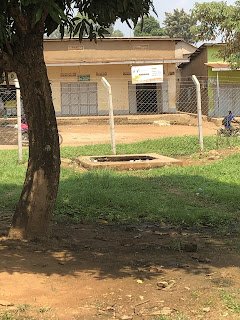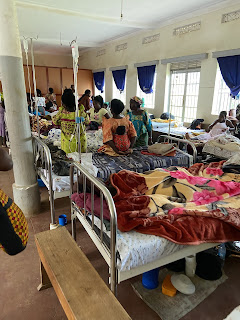Study Theme: Water, Sanitation, and Hygiene
Decoding WASH: from water to hygiene and sanitation in Rakai
Water, sanitation, and hygiene (WASH) falls under the sixth
development goal as set forth by the United Nations to assure equal access to
clean water and sanitation. The WASH team had the opportunity to meet with the
National Water Service, the health inspector for the hospital in Kalisizo, and
a town health inspector in Rakai to inquire about the real-time processes and
problems faced in each aspect of WASH.
From spring to tap
The National Water Service (NWS) oversees many locations
spread throughout districts in Uganda and is responsible for water treatment
and sewage management. Boreholes are placed into underground water springs in
order to tap into natural water sources. Pumps connected to the boreholes
transport water from springs into collections of unprocessed water known as
sumps which contain small stones to filter out any dirt/bacteria from the water.
Water from the sumps is pumped into dosers, which help to automatically
chlorinate the water and kill any bacteria that may be present. There is a
worker on duty at all times to make sure that correct amounts of chlorine are
being added to the water: when there is heavy rainfall, more chlorine may be
added to account for extra bacteria and dirt found in the runoff. Chlorinated
water from the dosers is then pumped to the filtration site, which utilizes the
addition of more chemicals and sand in order to strain impurities out of the
water.
 |
| Water from the natural springs is collected in a sump pictured above. |
Filtered water is automatically pumped to the reservoirs,
where water can then be distributed to communities of Rakai through underground
piping systems. People without access to these piping systems may choose to
have their own private water source, however, this is not recommended by the
NWS. These people may choose to use chlorine tablets (1/2 tablet for every 1000 L of water) to clean
their water source or pay 25 shillings for
each jerrycan of water from a local water tap that is connected to the NWS. The
NWS works together with the local electric company to power its automated pumps
and also offers centralized sewage service. The system does not reach all
people of Rakai, however, and many people choose to have their own private
sewage tanks instead. In order to connect these people with the NWS sewage system,
they would have to be temporarily displaced from their homes while the sewer
lines are constructed. The NWS uses SMS messaging in order to communicate with
customers and pays a boda boda (motorbike for hire) driver
to provide important water announcements to the public who may not have access
to cell phones.
 |
| Automated pumps transport water throughout the entire NWS water processing pipeline. |
 |
| Chlorine is added to the water in containers known as “dosers”. |
Sanitation within the
Health facility
Regarding sanitation and waste management at the Kalisizo
General Health Facility, solid waste is segregated according to different bin
colors and liners: red bins for highly infectious material, black bins for
general waste such as paper and plastics, yellow bins for infectious material,
and brown bins for pharmaceutical waste. Some waste is incinerated, but wastes
that cannot be incinerated are denoted by green labels and transported for
proper disposal. Pharmaceutical wastes are taken by the National Medical Store
for disposal.
Wards are cleaned every morning, while latrines are cleaned
every morning and evening. Furthermore, there are separate latrines for
inpatients and outpatients. Since there are no hand washing facilities provided
near the latrines for patients in the health facility, there are also some
health risks.
While further touring the health facility, we were also informed
of a “placenta pit”, which is used to store placenta wastes from the maternity
ward. This placenta pit at the time had a broken cover, which can pose a health
risk to the Rakai community.
 |
| The lack of cover for the placenta pit creates a health risk for the community in Kalisizo. |
Hygiene and Waste
Management
The team also met with the health inspector for Kalisizo and
interviewed him on hygiene and waste management within the region. He outlined
the requirements necessary for the opening and maintenance of eating houses
(restaurants) such as but not limited to an STI and sputum test in addition to
a medical certification requirement which must be renewed every six months per
employee. He described the challenges these eating houses face as a result of
the high employee turnover rate—resulting in the need for recertification for
new employees. When discussing solid waste management, the inspector reported
that the primary means for waste removal in Kalisizo depends on its removal and
transportation by a tender to a dumping site about 4km away from the town. Lack
of funding, in turn, has resulted in routine dumping of rubbish and other solid
waste by the townspeople into alleys and along streets. Despite these
frustrations, the inspector mentioned efforts and potential solutions to the
waste problem via fee collection of the townspeople as well as the current
employment of about eight individuals responsible for sweeping the streets and
collecting trash.



Comments
Post a Comment